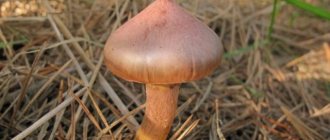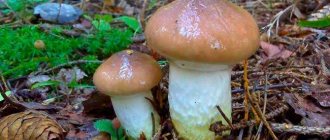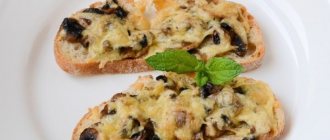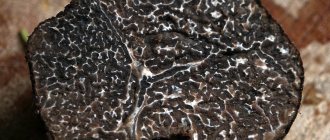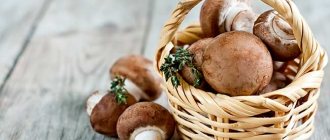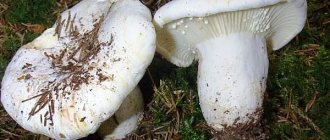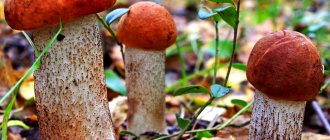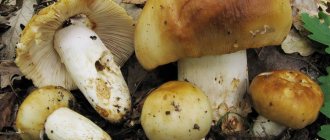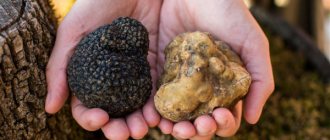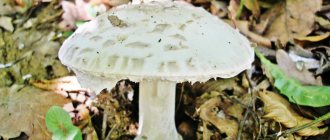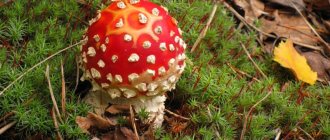Features of mokrukha
Any variety of mokrukha has a pleasant taste and aroma, provided that it is properly prepared. They have some things in common, but mostly the color and shape of the mushroom are different from each other. The most common type of moth is the spruce moth:
- The cap of this type of mushroom reaches 14 centimeters in diameter, gray-brown or gray in color. There may be spots on top, and there may be a purple or lilac tint. In newly ripened mushrooms, the shape of the cap is hemispherical; over time, it becomes spread out and depressed. Almost all mushrooms have a small tubercle in the middle of the cap. The skin is soft, sticky and easily peeled off.
- Leg. Reaches a height of 14 centimeters, has a lemon color below and gray above. If you press on it a little, the leg will darken slightly; most often the entire leg is covered with scales. The leg mates with the cap with a kind of blanket of mucus; the leg, like the cap, is sticky.
- Records. In young mushrooms, the plates are white or gray; the older the mushroom, the darker it becomes, eventually becoming completely brown. The plates are thick, branched with a mucous covering.
- The flesh has a pink or white tint; in old mushrooms the flesh is gray, and at the very bottom it is yellow. The aroma is weak and the taste is sour.
The first description of the spruce fly was made by the well-known botanist Schaeffer Jacob. He classified this type of mushroom as a champignon and called it “Agaricus glutinosus,” which translated means a molar.
Use in cosmetology
Mokruha extract is a remedy well known to professional cosmetologists. This substance is sometimes included in creams and masks for aging skin. Substances contained in mushrooms help maintain smoothness, firmness and elasticity of the skin. Masks with moruka extract are useful for tightening pores, eliminating oily shine and improving complexion.
The benefits of this amazing mushroom are also felt by the hair. Masks made from the crushed product are useful for split ends, and a decoction of mushrooms is useful for rinsing weakened, dull curls. You can also stop baldness with the help of mokrukha. Regular use of mushroom cosmetics will give excellent results in the form of shiny and healthy hair.
Varieties
The mokrukha mushroom has several species, all of them from the same genus, but outwardly different from each other. The pulp of the cooked mushroom has a pleasant taste and aroma, so when going for mushrooms, a mushroom picker should know what each variety of mushroom looks like.
Wet pink
This type of mushroom is considered edible, but after preliminary boiling. Features of pink mokrukha:
- The hat grows small, only 6 centimeters in diameter, pink-gray in color, its edges are wavy. In the middle the color quickly fades and the cap becomes pale pink. You can recognize a young mushroom by the shape of its cap - in a young mushroom it is convex and slimy, while in an old one it is spread out.
- The leg reaches a height of five centimeters - no more, smooth, cylindrical in shape. There is a mucous ring on the stalk, which gradually disappears as we age.
- The plates are thick, slimy and sparse. In a young mushroom they are white, while in an old one they are purple or gray. The bottom of the leg is soft pink, which is where the name comes from.
Eating. Before cooking mushrooms, they must be peeled, boiled, and then can be fried, pickled or dried.
When and where does it grow? You can see the pink moth in a forest clearing from July to September. Mushrooms grow in pine forests with a lot of moisture.
Purple moth
This lamellar type of moth is quite rare, but edible; it is also called mucous moth or shiny one. The color does not have to be purple, as the name suggests. They named it that way because when exposed to extreme heat, it always takes on a purple hue:
- Hat. Grows up to 14 centimeters in diameter. The color is shiny, red with a brown tint, brick red or lilac. A young mushroom has a conical hat with a prominent tubercle, and as it ages, it becomes convex and spread out. After the rain passes, it becomes covered with thick mucus and has a brown blanket. The edges are curved inward.
- Leg. Reaches 10 centimeters in height, the shape is curved, cylindrical in shape. The color of the stem is the same as the color of the cap, slightly sticky.
- plates that are easily separated from the cap. The color of the plates is purple or lilac; they darken with age, and in very old mushrooms they acquire a black tint.
- Pulp. The bottom is fibrous and fleshy. If the pulp is broken, you can see a yellow color, and when exposed to air it turns red. There is no strong taste or smell. This type of mushroom is simply loved by various insects, so before you put it in the basket, you should carefully examine it from top to bottom.
Similar mushrooms. Edible moths: felt, spruce, Swiss, pink, spotted. They differ in the following criteria: the felt mushroom has white pubescence on the cap, the spruce mushroom differs in that it grows exclusively near or under the tree. As for the Swiss moth, its cap is ocher with felt pubescence. The pink moth has a pink hat and light-colored plates.
When and where does it grow? Purple moth ripens from August to September on the Eurasian continent. As for Russia, this mushroom can be found in European territory, Siberia and the Caucasus. Purple moth grows in coniferous, mixed and coniferous forests near birch and pine.
Spruce fly
Spruce fly is an edible mushroom. Its main features:
- Appearance: cap with a gray-brown tint. A purple tint may be noticeable. Diameter – 12 cm.
- Similar mushrooms. Relatives of spruce moth are also edible: purple moth, spotted moth, mushrooms with dark-colored caps similar to boletus mushrooms. The difference is that butter mushrooms do not have plates, and in the place where the buttermilk is broken, the flesh turns red.
- Benefits when growing. Spruce fly can be collected or specially grown for the sale of raw materials in the pharmaceutical sector. In folk medicine, a tincture of spruce fly is made, which serves as an antimicrobial agent.
Spotted biter
It is also called mucous, they grow near larches and fir trees:
- Hat. There are small dark brown spots on the cap. At the site of the break, the flesh turns red. The plates are white and sparse, and with age they acquire a dark shade.
- The leg is dirty dark, completely curved, dense, and has yellow spots on it. The leg reaches seven centimeters in length. It is connected to the hat by a mucous film, which over time turns into a ring that envelops the top of the leg.
- Records. The mushroom has sparse plates, have a branching shape, they lie on the top of the stem. When the mushroom is young, the plates are white, but with age they become brown.
- Pulp. The color is white or yellow, and in air it takes on a red tint. The spore powder is dark green in color.
When and where does it grow? This mushroom can be found in Eurasia and North America. Mushrooms grow in small groups among moss and thickets. This species can be found in coniferous and deciduous forests.
Before consuming the mushroom, it should be boiled for a long time, and then it can be fried, pickled or dried.
Felt mokrukha
It is also called fleecy moth, due to the fact that the pile covers the mushroom cap.
- The cap is smooth, reaching 10 centimeters in diameter. There are small grooves on the edge. Orange-colored plates hang down and cover the stem of the mushroom.
- The plates are sparse and wide, sliding down the stem.
- Mushroom pulp can be of different shades of ocher, quite dense, and as it ages it acquires a brown tint.
- The leg is smooth, the color is the same as the cap, the leg is slightly thicker in the middle. Brown spores with a dark tint.
Where and when does the mushroom grow? The felt fly can be found in nature reserves near fir or pine trees. Most often they grow in large groups in the autumn.
Use in folk medicine
In folk medicine, moths are known as a medicine against neurodermatitis. As a rule, alcohol tinctures or ointments with mushroom extract are used for treatment. In some regions, tinctures against staphylococcus are prepared from these organisms. But in order for the mushroom to retain its healing properties, herbalists strongly recommend that before pouring alcohol into it, do not clean it of mucus. Alcohol tinctures from mokrukhs are infused for 15-17 days, shaking the vessel regularly. The finished infusion is filtered through cheesecloth and stored at room temperature. Traditional healers recommend using this tincture for wiping pustules, and you can also drink 5-20 drops of it for sinusitis.
Composition and beneficial properties
Any mushroom is a nutritious and at the same time heavy product. The mushroom, called mokrukha, contains many useful components. Calorie content is 19 kilocalories per 100 grams of product:
- 0.9 grams of protein;
- 0.4 grams of fat;
- 3.2 grams of carbohydrates.
The mushroom also contains the following vitamins:
- RR;
- E;
- WITH;
- IN 1;
- AT 2.
Protein is absorbed by the body very well, even better than meat, which is extremely good for vegetarians. These mushrooms can be eaten even if you are on a diet.
Benefits for the body
Mokruhi, in particular pine, are considered an excellent remedy for strengthening the immune system, but this is far from the only benefit of this product. Experts who studied the chemical composition of these organisms came to the conclusion that moths can be beneficial for most people. Eating these mushrooms helps improve memory, combat chronic fatigue and improve body tone. Some of the substances contained in mushrooms contribute to the process of hematopoiesis. The benefits of this forest product can be felt by people suffering from chronic migraines, weakness, insomnia, and disorders of the nervous system. Thanks to the natural antibiotic contained in this product, it is useful in fighting viral diseases.
Is it possible to grow mothweed yourself?
You can grow mokrukha mushrooms yourself using mycelium. To do this, follow the steps:
- Mokrukha mycelium is mixed with 500 grams of sand.
- Next, you should loosen the soil before planting.
- A depression of about 10 centimeters is made in the soil.
- The mycelium is sprinkled evenly over the entire soil (one package is enough per square meter of soil).
- The top is covered with forest soil, which was previously mixed with humus in a 1:1 ratio.
- Watered with water (10 liters per square meter).
- Covered with loose soil.
Planting can be done at any time of the year under coniferous trees. The mycelium grows exactly as long as the tree. In summer, the area needs to be watered several times a day. The first harvest can already be harvested 2.5 months after planting; in general, weeds can be harvested four times a year. When there are no mushrooms on the site, the site is covered with humus at a rate of 15 kilograms per square meter.
There are several varieties of morukha mushroom, each of them differs in appearance and place of birth. All types of mokrukha are edible, but only after preliminary boiling. The taste of the mushroom is not bad; in some countries it is even considered a delicacy. But before you start eating the dish, you should familiarize yourself with the contraindications to avoid problems with the body.
0
0
Copy link
Use in cooking
Mokruhi can be boiled, fried, dried, pickled and pickled. They are suitable for making sauces, soups, casseroles. Cooking these mushrooms is not difficult. For example, spruce moths can be boiled for only 15 minutes - this is enough to make them safe for consumption. After exposure to high temperatures, the flesh of mushrooms usually changes color (darkens or turns purple), but this should not be alarming. Changes in color do not affect the nutritional characteristics or taste of the product. Morukh is prepared according to the same principle as boletus. Before cooking, the caps and stems must be thoroughly cleaned of the mucous layer.
wet girl
Dictionary of Russian argot. - GRAMOTA.RU. V. S. Elistratov. 2002.
See what “mokrushka” is in other dictionaries:
Mokrushka - Characteristics Length 14 km Basin Kara Sea Watercourse Kamyshenka Estuary · Location 21 km along the left bank Location ... Wikipedia
mokrukha - mokrukha, and, mokrushka, and, well. 1. Same as sputum, 1. 2. Same as wet tail... Dictionary of Russian argot
Upper Kudat - Characteristics Length 18 km Basin Kara Sea Watercourse Estuary Peschanaya · Location 252 km along the right bank Location ... Wikipedia
Upper Taurachek - Characteristics Length 10 km Basin Kara Sea Watercourse Estuary Peschanaya · Location 185 km along the right bank Location ... Wikipedia
Upper Etogol - Characteristics Length 23 km Basin Kara Sea Watercourse Estuary Peschanaya Location 195 km along the left bank Location ... Wikipedia
Volchikha (tributary of the Savikha) - Volchikha Characteristics Length 16 km Basin area 62 km² Basin Kara Sea Watercourse Mouth of the Savikha · Location 2 km along the right bank ... Wikipedia
Vydrikha (tributary of Maralikha) - This term has other meanings, see Vydrikha. Vydrikha (Prav. Vydrikha) Characteristics Length 32 km Basin Kara Sea Watercourse Mouth of Maralikha · Location 42 km along the right bank ... Wikipedia
Vyatchikha - Characteristics Length 20 km Basin Kara Sea Watercourse Estuary Anui · Location 184 km along the left bank Location ... Wikipedia
Gavrilovka (tributary of the Belaya) - This term has other meanings, see Gavrilovka. Gavrilovka Characteristics Length 14 km Basin Kara Sea Watercourse Estuary Belaya Location 48 km along the right bank ... Wikipedia
Generalka (tributary of the Baschelak) - This term has other meanings, see Generalka. Generalka Characteristics Length 14 km Basin Kara Sea Watercourse Mouth Baschelak · Location 26 km along the right bank ... Wikipedia
Source
Cooking recipes
Mokrukha is great for preparing any dishes, and it can be prepared in different ways.
IMPORTANT!
The moth should be processed quickly after collection; in a warm room it can accumulate harmful substances. The maximum shelf life of unprocessed yellowlegs is one day.
Cooking the mushroom is easy; it does not require special skills or soaking.
Primary processing
At the initial stage of preparing yellowlegs, it is necessary to remove the mucous film from its cap. After this, they are washed in running water, then they can be boiled, fried, salted and pickled. Dried and frozen mushrooms are good. They can be prepared by cutting lengthwise and spreading the halves in different directions, this way the film is removed faster.
Cooking
Allow about 15 minutes for it, after which the liquid is drained and the mokrukhas are allowed to cool. When cooked, their color becomes lilac or, as the name suggests, purple, but the taste and smell remain unchanged. After this, the mushrooms can be subjected to other types of processing or added to soup.
Pickling
To marinate, boil purple mokruki in salted water with a pinch of citric acid. After boiling, keep on the fire for 20 minutes, drain the liquid, rinse the mushrooms, and then:
- Pour water into a deep saucepan, add sugar at the rate of 90 g per 1 liter, allspice, cloves, salt, bay leaf and 100 ml of vinegar;
- put on fire, bring to a boil, add mokruki;
- after boiling for 20 minutes, they will sink to the bottom, then you can put them in jars, adding marinade.
IMPORTANT!
The liquid should completely cover the mushrooms, and for greater preservation, pour 1 tbsp on top of them. l. vegetable oil. Close the jars with lids and store in the refrigerator or cellar.
Freezing
After boiling, the product can be frozen. Then they will pamper you all winter with tasty and healthy purple fungi. It is enough, when they have cooled down, to put them into portioned containers and put them in the freezer.
Frying
You can fry yellowlegs on its own, mixed with other mushrooms, as well as onions and vegetables. Mokrushki baked with potatoes or meat are good. You don’t need to fry them for a long time, just simmer them a little, the color remains just as bright and unusual. No further cooking is required; you can safely eat it. Scrambled eggs would be a nice extra dish.
Pickling
After cleaning and preliminary boiling, the purple mocha is laid out in layers in prepared containers, sprinkling each of them with salt and your favorite spices. Most often, garlic, allspice, dried dill and cloves are used. If desired, you can add bay leaf.
- Having covered the top layer with salt, you need to cover everything with gauze folded in several layers, put a wide plate on top and put pressure on it.
- After 5 days, juice will appear and should completely cover the mushrooms.
- The gauze should be changed periodically or thoroughly rinsed.
- After 40 days, you can put everything in jars or put it directly on the table.
According to reviews, salted mokushki are not as tasty as pickled ones.
Drying
With this method of processing, the mushrooms should not be washed; it is enough to clean them of forest debris and remove the tasteless film from the cap. Drying is carried out outdoors or in the oven. The mokruhi should become completely dry, having lost all the liquid; when pressed, they will break with a crunch.
You can start the process outside and then finish it in the oven. Such mushrooms should be stored in a closed jar or canvas bag. The only drawback of this method of harvesting moths is its mucus, which is quite difficult to completely remove when cleaning.
Canning for the winter
To do this, you will need to boil the yellowlegs in salted water for 30 minutes, then drain the broth and rinse the mushrooms. It is better to cut large specimens, small ones can be left as is.
To prepare marinade from 1 liter of water you will need:
- boil it in a prepared container;
- add salt, spices (3 cloves, 1 bay leaf, 3 peppercorns),
- currant leaves and finely chopped garlic (4 cloves);
- boil the mixture for 15 minutes, add 100 ml of vinegar and cook for another 5 minutes.
The marinade is ready, add mushrooms and keep on fire for another 15 minutes. Afterwards, the yellowlegs are placed in sterilized jars and poured with hot marinade so that it completely covers them.
Sterilize for 30 minutes, roll up the lids and wrap in a blanket. After a day you can put it away for storage. Harvesting for the winter is not complicated and is similar to the process of preparing other mushrooms.
Video gallery
Description of the mushroom
Mokrukha is a conditionally edible mushroom that belongs to the fourth category of edible mushrooms. That is, in order to eat it, the mushroom must first be soaked and then boiled. Some housewives use it as an addition to various sauces, dried, salted and pickled.
The Mokrukhov family can be divided into two genera, called Chroogomphus and Gomphidius. A distinctive feature of these mushrooms is to form a wet, slimy film on the cap. These gifts of the forest are always slippery to the touch. It is this characteristic feature that confuses many mushroom pickers.
Wetweeds can grow either singly or in small families. Active growth of representatives of this family is observed from the beginning or mid-July until the first frost.
Places where mokrukhs grow
Wetweeds are far from uncommon in coniferous or mixed forests. They can be found in moss under pine, spruce or fir trees. Mass gathering of mushrooms, which are avoided by beginner mushroom pickers but appreciated by experienced ones, occurs in late summer and early autumn.
Mokrukhs prefer calcareous soils, they love elevated places and thinned forest plantations. They are often found in the vicinity of butterflies. In Russia they grow everywhere only in Siberia, the Far East and the North Caucasus. In European territory, mushrooms can be found less frequently, mainly in areas with snowy winters and hot, short summers.
False doubles
The spruce fly does not have poisonous counterparts, which is a great advantage of the species.
Sometimes it can be confused with similar-looking edible varieties:
- Mokruha is spotted: the fracture of its flesh has a red tint, and there are dark inclusions on the surface of the mushroom.
- Another edible doppelgänger is the purple moth. It is distinguished by orange-brown flesh and dark purple plates.
- Often, because of the dark cap, spruce fly is confused with boletus, but the latter do not have plates.
Collection rules
To avoid negative consequences, you must adhere to the main rules for collecting spruce bits:
- The fruiting body is carefully cut off with a sharp knife so as not to damage the structure of the mycelium.
- It is best to place mushrooms in a wicker basket so that they do not turn the specimens lying nearby purple. The best option is to sort mushrooms by type.
- Old moths should not be cut off as they may be rotten inside. Collected specimens must be checked for worms.
- It is best to start harvesting in the morning, before most of the moisture has evaporated from the mushrooms. This way, mokruki will retain a maximum of useful substances in their composition.
- The optimal time for harvesting mushrooms is after warm rain. It is not recommended to go out on a “quiet hunt” in dry weather.
It is important to process the collected mushrooms as soon as possible so that they do not spoil and retain their beneficial properties. Spruce bits are carefully sorted and cleaned of dirt, earth clods and pine needles. Afterwards, it is better to place the raw materials in a cool place. For long-term storage, mushrooms can be placed in the freezer. When frozen, fruiting bodies can be stored for 10 to 12 months.
Important! Before freezing, the fruiting bodies must be boiled.
The truth about slippery mushrooms
In terms of taste characteristics, mokrukha are significantly inferior to more expensive representatives of this kingdom. Of course, they are not as tasty as white or champignons. However, in terms of the content of a large amount of nutrients and antibacterial components, they are ahead of all types of mushrooms found in the central zone of our country. Some biologists and botanists call the moth family a storehouse of proteins, carbohydrates, amino acids and consider them indispensable in therapeutic nutrition. By the way, during cooking, the mokrukha mushroom turns black.
